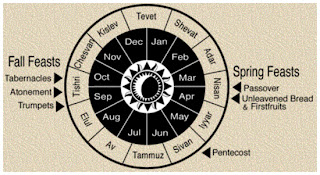The feast of Shavuot (pronounced Shav – oo – ot) is one of
the 7 feasts found in Leviticus 23. Shavuot
comes from the Hebrew term “weeks” which is a major part of the feast, the
counting of 7 weeks. Most Christians
know this feast by its Greek name, Pentecost.
This feast counts fifty days from the Sabbath of the Passover and
Unleavened Bread festival. Hence the
Greek name Pentecost which means “fifty.”
This year, the feast is celebrated between May 26-28 or the third month
of the Jewish Calendar. It is also
called the “Feast of Harvest” in Leviticus 23:16.
In the last post (below) I have a brief introduction to the
feasts. In summary, the feasts can be
divided into two major categories, the spring and fall feasts. The spring feasts begin with Passover, which
is the start of the new year according to Exodus 12 and Leviticus 23. So
Passover starts on the 14th of the 1st month. The next day begins Unleavened Bread that
lasts for 7 days. During this 7 day
feast of Passover/Unleavened Bread there is a Sabbath. That Sabbath is significant because that
begins the count down for 7 weeks (49 days) of counting and then
Shavuot/Pentecost feast begin on the 50th day.
Some features of this feast according to Leviticus 23:15-22
show that on this day, each person is to bring two loaves of bread to the
Tabernacle/Temple and wave them. Most
likely they were to hold a loaf in each hand and wave them. While Passover and the Feast of Unleavened
Bread marked the beginning of the Exodus out of Egypt, this feast marked the
end of the Exodus and the giving of the Law.
The book of Exodus, in 19:1-2 shows that the people of Israel came to
Mt. Sinai in the third month and camped there while Moses went up the mountain
to get the Law. The observance of
Shavuot was connected to the giving of the Law, something that Jews even today
associate Shavuot with in their celebration.
In fact, part of the current Jewish celebration is to read the Torah all
night long on the first night, with special emphasis on the 10
commandments. It is here, at Mt. Sinai
that Israel was given the Law and where they became a “holy nation.” One of the most significant events of this
time was fire. Exodus 19:18 states that
Mt. Sinai was in smoke because the LORD descended upon it in fire. Some even
wonder if the two loafs being waved were symbolic of the two tablets of the 10
commandments in Moses’ hands.
In the NT, this feast is only mentioned by name 3 times
(Acts 2:1; 20:16; 1 Cor. 16:8). The most
significant is Acts 2, which is probably the most familiar to many
Christians. It is here that the first
converts to Christianity begin to speak in tongues of fire. Christ promised in Acts 1:5 that not many
days they would be “baptized by the Holy Spirit.” We see this happen at Pentecost in Acts
2. We also know from 1 Cor 12:13ff and
Gal 3:26-29 that the Spirit baptizes believers into the body of Christ. This mean that the Holy Spirit places a
believer into union with Christ and with other Christians. In essence, Acts 2 shows the birth of the
Church and the giving of the Spirit.
This event was something unique up to this point in redemptive history.
How amazing is that?
The same holy feast that God had appointed (Lev. 23:1) would be both the
birth of Israel and the birth of the Church many many years later. Here are a few more interesting
connections. Under the Mosaic Covenant –
Fire on the Mountain, the giving of the Law, the Law written on stone and the
birth of the nation. Under the New
Covenant – Fire on believers, the giving of the Spirit, the Law written in the
heart through the ministry of the Spirit and the birth of the Church.
What a holiday worth looking back on and celebrating. This should give us a great appreciation of
the OT and how as NT believers, books like Leviticus shouldn’t be crispy! I trust this was encouraging. If it was, please leave a note. If I see this as something beneficial to
others, I’ll do more. But If I am the
only one reading this, well I’ll save the time, haha.



